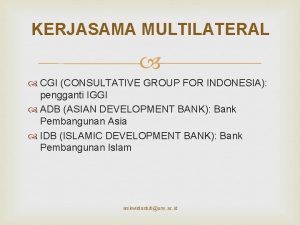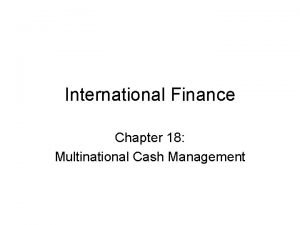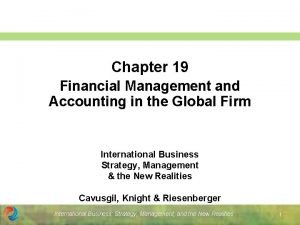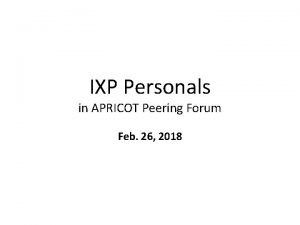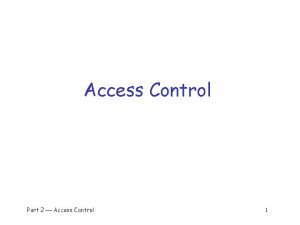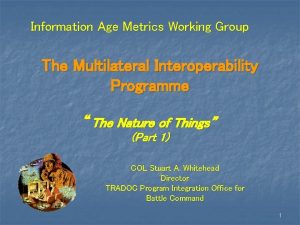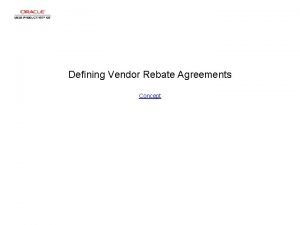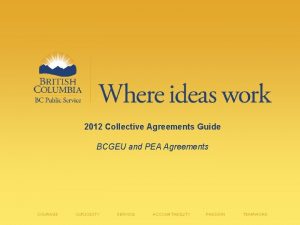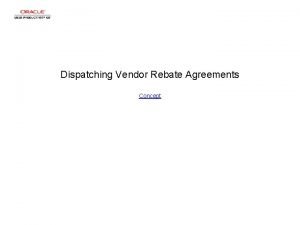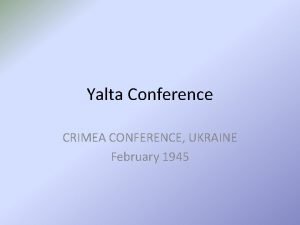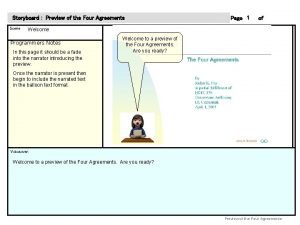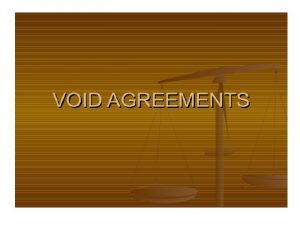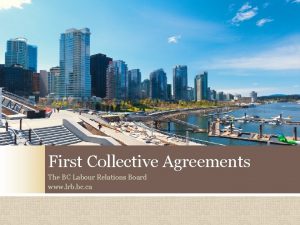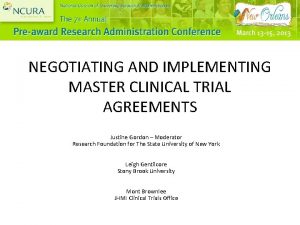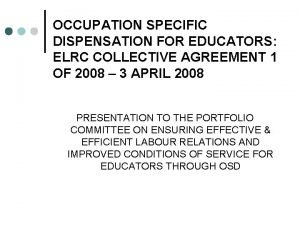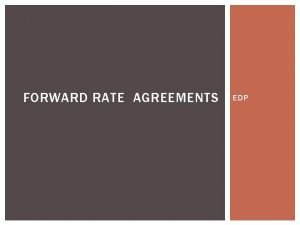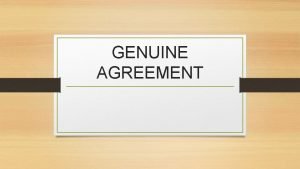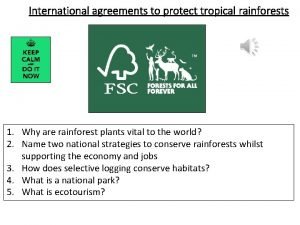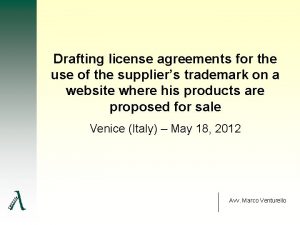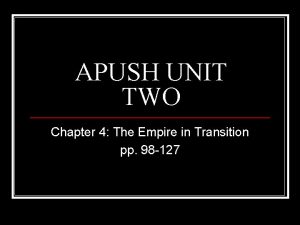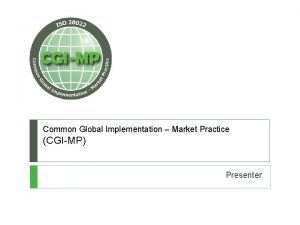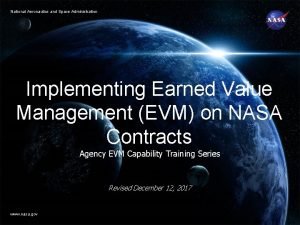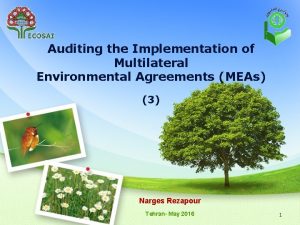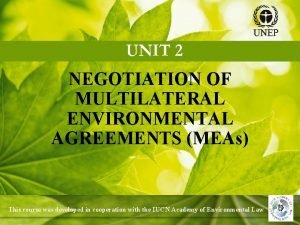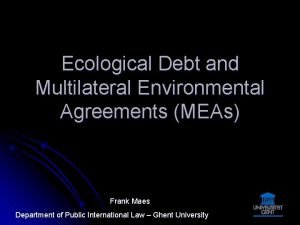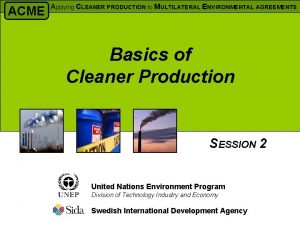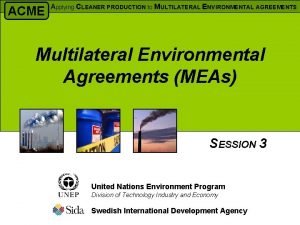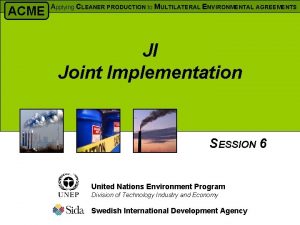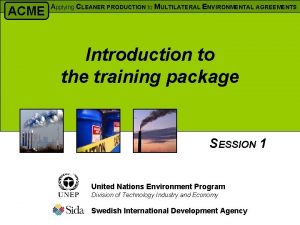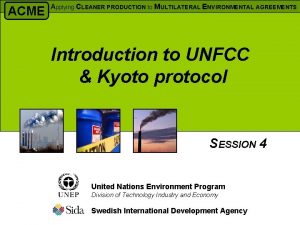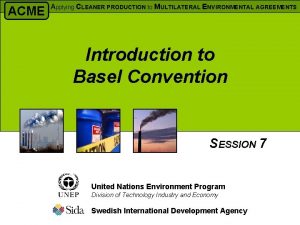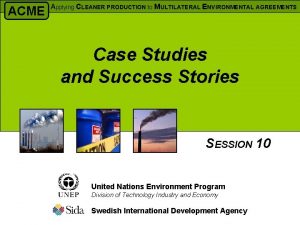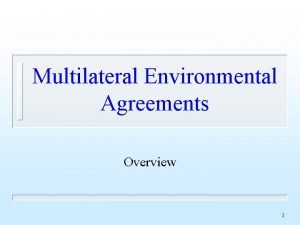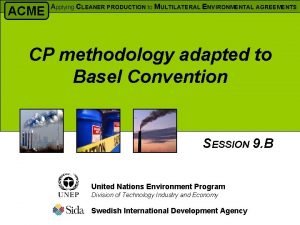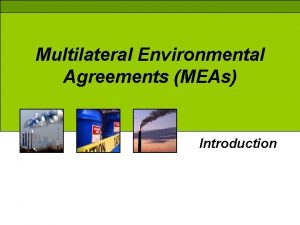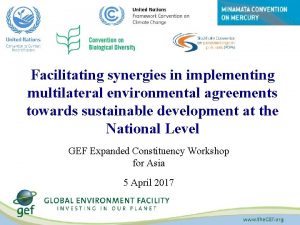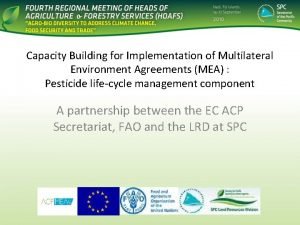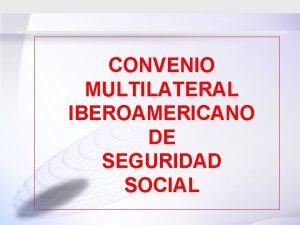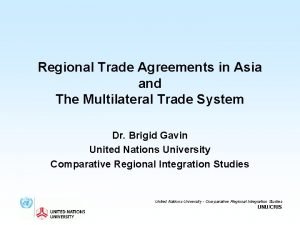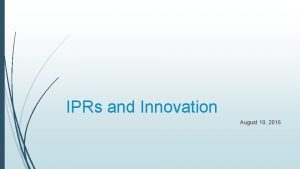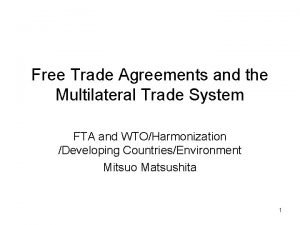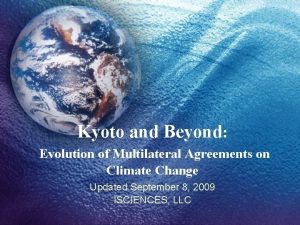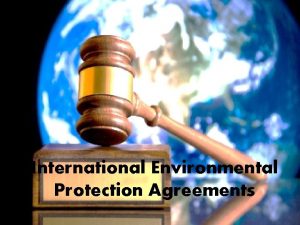IMPLEMENTATION OF MULTILATERAL ENVIRONMENTAL AGREEMENTS This course was






































- Slides: 38

IMPLEMENTATION OF MULTILATERAL ENVIRONMENTAL AGREEMENTS This course was developed in cooperation with the IUCN Academy of Environmental Law

What is Implementation? Once a State has ratified a treaty, the State implements treaty at the domestic level when it adopts appropriate domestic measures to meet its obligations under the treaty Implementation measures could include adopting or modifying policies, legislation, commitment of resources, institutional development, etc. If a State has not adopted implementation measures, it may be difficult to enforce an MEA in national courts. Note the difference between monist and dualist States as to whether an MEA has become part of national law This course was developed in cooperation with the IUCN Academy of Environmental Law 2

What is the Relationship between Implementation and Compliance? Compliance reflects a state of fulfilling an MEA’s obligations Implementation refers to the various measures undertaken to comply with an MEA: 1. 2. 3. Adopting domestic implementation measures Enforcing those measures Reporting on implementation measures Thus, compliance and implementation are related, but distinct This course was developed in cooperation with the IUCN Academy of Environmental Law 3

Implementation in IEL To address new global or regional environmental concerns, it is often necessary to develop new legal mechanisms, such as MEAs New MEAs will not address the concerns if they are not translated into action Thus, MEAs are of limited value unless they are adequately implemented It is important that the substantive rules of MEAs possess internal force and dynamism that invokes an attitude of compliance Subsequent compliance measures are essential to implementation processes This course was developed in cooperation with the IUCN Academy of Environmental Law 4

Compliance Measures to Enhance Implementation Sources of compliance measures: – measures can be included in the text of an MEA; – the COP can devise measures; and – the COP can instruct the Secretariat to devise measures Measures may include: – clear and unambiguous language in an MEA; – expressly requiring implementation in an MEA; – provisions that require Parties to report on and monitor compliance; – providing terms for mechanisms to monitor compliance and address non-compliance; and – empowering the MEA secretariat to periodically assess and evaluate compliance & consider additional measures aimed at compliance This course was developed in cooperation with the IUCN Academy of Environmental Law 5

Who is Responsible for Implementation? Responsibility for implementation of MEAs lies with Parties to the MEAs International institutions – inter-governmental organisations (IGOs) and institutions set up by MEAs – frequently support Parties: – E. g. , Conferences of the Parties (COPs), MEA Secretariats, etc. – MEA institutions have their own administrative bureaucracy to assist implementation and may be permanent or non-permanent May extend to policymaking, but that is usually reserved for the COPs Non-State actors often play a role – Monitoring, technical assistance, capacity building, awareness raising, etc. This course was developed in cooperation with the IUCN Academy of Environmental Law 6

IGOs involved in Implementation United Nations – – UN Environment Programme (UNEP) Commission on Sustainable Development (CSD) UN Development Programme (UNDP) UN Food and Agriculture Organization (FAO) World Bank Global Environment Facility (GEF) Regional institutions – Economic integration bodies – Regional development banks – Regional networks This course was developed in cooperation with the IUCN Academy of Environmental Law 7

The Role of Parties: National Measures for Implementation This course was developed in cooperation with the IUCN Academy of Environmental Law 8

Compliance Assessment Before ratifying an MEA, a State should assess its capacity to comply with an MEA This should be done early on in the negotiation process If areas of concern are discovered, this allows the opportunity to rectify before the MEA is finalized – In some cases, it may be necessary to change national, sub-national, and/or local laws This course was developed in cooperation with the IUCN Academy of Environmental Law 9

Compliance Plans Means to promote compliance – Usually designed to address non-compliance (may be following ratification, or later) Develop a compliance plan to address areas of noncompliance – Identify specific areas of non-compliance – Identify corrective measures – Identify benchmarks for determining if problems have been corrected Case study: New Zealand plan to implement the Kyoto Protocol This course was developed in cooperation with the IUCN Academy of Environmental Law 10

National Implementation Plans (NIPs) May be required by an MEA and may include: – Environmental effects monitoring & evaluation to determine whether an MEA leads to environmental improvement – National policies, plans, and programmes to ensure effective implementation in identified sectors May also be integrated with poverty reduction strategies Drafting of NIPs should be transparent, inclusive, and participatory Case study: Developing strategies for implementing the Aarhus Convention in South This course was developed in cooperation with the IUCN Academy of Environmental Law Eastern Europe 11

Legal and Regulatory Frameworks Development and adoption of implementing laws and regulations are vital to implementation of and compliance with MEA Laws must be regularly reviewed (and revised as appropriate) to ensure continued compliance Devising a regulatory framework may present challenges, particularly for smaller and developing countries This course was developed in cooperation with the IUCN Academy of Environmental Law 12

Enforcement Implementing laws and regulations must include provisions for enforcement: – Inspection authority – Enforcement authority – Penalties and other sanctions May also set up programmes to deter, punish, and redress violations This course was developed in cooperation with the IUCN Academy of Environmental Law 13

Use of Economic Instruments Alternative approaches to implementation and compliance can include reliance on fiscal instruments such as: – – Pollution and other taxes Tax incentives Fees Tradable Permits Benefits – Can raise funds for environmental protection and enforcement costs – “Internalizes” environmental costs into the costs of doing business (polluter-pays principle) – Provides businesses with incentives to reduce environmental impacts, while according flexibility in how to achieve these reductions This course was developed in cooperation with the IUCN Academy of Environmental Law 14

National Focal Points Parties may identify national authorities as focal points for a specific MEA or cluster of MEAs – E. g. , biodiversity MEAs; chemical & waste-related MEAs Political focal point: – Usually the foreign affairs ministry – Coordinates international processes (e. g. , liaise with the COP, Secretariat, etc. ) Technical focal point: – Usually the environment ministry – Implements MEA at the national level in collaboration with other environment-related ministries or departments Case study: Coordination of MEA focal points and institutions in the Republic of the Congo This course was developed in cooperation with the IUCN Academy of Environmental Law 15

Coordinating and Strengthening Institutions Parties must identify the various government departments or agencies responsible for implementing an MEA – May have primary or secondary responsibility Need for cooperation and coordination when developing and implementing NIP or programmes for MEA implementation Also need to build institutional capacities to ensure compliance This course was developed in cooperation with the IUCN Academy of Environmental Law 16

Public Awareness and Stakeholder Involvement The national media should be utilised to build public awareness about MEAs Education programmes in primary, secondary, and post-secondary schools Stakeholder involvement – when developing NIP or programmes for MEA implementation – in enforcement – Stakeholders may include NGOs, industry, local communities, women, youth, etc. This course was developed in cooperation with the IUCN Academy of Environmental Law 17

Capacity Building and Technology Transfer Crucial to ensure compliance among developing and least developed countries that may not have capacity to implement MEAs May include financial and technical assistance – including mechanisms such as the GEF May be provided for in an MEA – and/or developed subsequently Must be appropriate to the needs and priorities of the country All stakeholders must be involved Can be undertaken at regional or sub-regional level Case study: Bali Strategic Plan for Technology Support and Capacity Building This course was developed in cooperation with the IUCN Academy of Environmental Law 18

International Cooperation Parties can improve MEA implementation through cooperative efforts at the bilateral, regional, and international levels to: – Generate information for assessing compliance – Assist with capacity building and technology transfer – Share national, regional, and sub-regional experience and plans – Assist in formulating guidance materials, including model legislation for implementing MEAs – Foster awareness among non-parties This course was developed in cooperation with the IUCN Academy of Environmental Law 19

Intergovernmental Organisations (IGOs) and Implementation This course was developed in cooperation with the IUCN Academy of Environmental Law 20

UNEP United Nations Environment Programme Conceived at the 1972 Stockholm Conference on the Human Environment Facilitates international cooperation on environmental matters UNEP includes various relevant divisions – Division of Environmental Law & Conventions, which prepares drafts of treaties (e. g. , CITES, CBD, Basel Convention, CMS) – Division of Environmental Policy Implementation – Division of Regional Cooperation Maintains or supports secretariats for many MEAs This course was developed in cooperation with the IUCN Academy of Environmental Law 21

Commission on Sustainable Development (CSD) Created in 1993 after the 1992 UN Conference on Environment and Development (the “Rio Earth Summit”) It is a functional commission within the UN Economic and Social Council (ECOSOC) Monitors sustainable development across the world by monitoring progress in implementation of Agenda 21 This course was developed in cooperation with the IUCN Academy of Environmental Law 22

United Nations Development Program (UNDP) Created in 1965 to administer and coordinate technical assistance for developing countries Has adjusted priorities to include environmental activities as part of development activities Sustainable Energy and Environment Division coordinates environmental programmes Other UNDP programmes contribute indirectly to environmental protection by addressing underlying problems of environmental degradation such as poverty This course was developed in cooperation with the IUCN Academy of Environmental Law 23

Global Environment Facility (GEF) Established in 1991, the GEF is implemented by the World Bank, UNEP, and UNDP The GEF is a financial mechanism that provides grants to developing nations to assist them in addressing specific global environmental problems, such as: – climate change – protection of international waters – safeguarding biodiversity – preventing further depletion of ozone layer – combating desertification – controlling persistent organic pollutants It is also an interim funding measure under some treaties (e. g. , Convention on Biodiversity and the UN Framework Convention on Climate Change) This course was developed in cooperation with the IUCN Academy of Environmental Law 24

MEA Institutions and Implementation This course was developed in cooperation with the IUCN Academy of Environmental Law 25

Conference of the Parties The primary policy-making organ of most MEA regimes Typically occurs once every one or two years Monitor, update, revise and enforce conventions Can also review the state of science – Example: Article 7 of the UN Framework Convention on Climate Change This course was developed in cooperation with the IUCN Academy of Environmental Law 26

Secretariats (1) May be part of an existing IGO – UNEP provides secretariat services for CITES, Basel Convention, Ozone Convention, CBD, CMS, and their relevant Protocols May be a stand-alone institution – Climate change secretariat This course was developed in cooperation with the IUCN Academy of Environmental Law 27

Secretariats (2) Responsible for the day-to-day operations of the MEA, usually including: – Monitoring and reporting on MEA implementation – Assisting with implementation (e. g. , through technical assistance and capacity building) – Promote scientific research relevant to the MEA’s objective – Contribute to the further development of law – Assist with communication between Parties Structure, size, and effectiveness varies from Secretariat to Secretariat This course was developed in cooperation with the IUCN Academy of Environmental Law 28

Functions of Secretariats This course was developed in cooperation with the IUCN Academy of Environmental Law 29

Information Gathering Secretariat often acts as an information clearinghouse for the MEA – Example 1: Party reports under Montreal Protocol on quantity of ozone depleting substances – Example 2: Party reports regarding the amount of hazardous waste imported or exported under the Basel Convention Receive annual or biannual reports from Parties and compile it in uniformats for effective use at COP This course was developed in cooperation with the IUCN Academy of Environmental Law 30

Record Keeping Some MEAs require the secretariat to maintain official, technical, and other annexes essential to the MEA. – Example 1: CITES Secretariat maintains different appendices to Convention which list all the regulated species – Example 2: Bureau of the Ramsar Convention maintains a list of designated wetlands and a list of conservation targets This course was developed in cooperation with the IUCN Academy of Environmental Law 31

Supporting the Conference of the Parties (COP) The Secretariat: – prepares and supports the annual or biannual conference of the parties – Prepares, translates, and circulates official documents – Handles logistics of the COP – Prepares background papers on specific issues to promote the further development of the MEA This course was developed in cooperation with the IUCN Academy of Environmental Law 32

Treaty Coordination Coordinate activities with other Secretariats and institutions – Example: Memorandum of Understanding between Secretaries-General of Ramsar and CBD, for Ramsar to assist CBD on issues relating to wetlands and inland water ecosystems Can also coordinate with institutions not dealing directly with environment (such as the World Trade Organization) This course was developed in cooperation with the IUCN Academy of Environmental Law 33

Monitor Compliance & Facilitate Implementation In most instances, the Secretariat has no enforcement authority, but it does have the power of persuasion to bring a violating party into compliance – Non-compliance mechanisms can include more significant measures to encourage or compel compliance Can identify areas of non-compliance and bring it to attention of COP or specific parties involved Provide or arrange for technical support to assist parties (especially developing states) to improve This course was developed in cooperation with the IUCN Academy of Environmental Law compliance 34

Subsidiary Bodies and Committees Created pursuant to an MEA, sometimes by a specific MEA provision Aim: address specific issues (e. g. , technical issues and furthering of technical cooperation) Examples – CBD Subsidiary Body on Scientific, Technical and Technological Advice (SBSTTA) – Ramsar Convention – Scientific and Technical Review panel (STRP) volunteer experts that advise Ramsar Bureau and Standing Committee on scientific matters This course was developed in cooperation with the IUCN Academy of Environmental Law 35

Non-State Actors and Implementation This course was developed in cooperation with the IUCN Academy of Environmental Law 36

Actors Generally speaking, – only States have rights and responsibilities in public international law – non-State actors such as NGOs and industry are not allowed to vote or participate in the final decision-making process Non-State actors may however act as observers and influence decisions Non-State actors are also important for MEA implementation: – – – Can build global networks Gather and analyse technical information Lobby domestic policy makers Help to build capacity Provide technical assistance This course was developed in cooperation with the IUCN Academy of Environmental Law 37

Differential Implementation Schedules & Obligations Facilitate implementation goals by developing countries – Example 1: Kyoto Protocol – Example 2: Montreal Protocol Based on the principle of common-butdifferentiated responsibilities While initially slowing implementation, differential obligations could be ultimately beneficial This course was developed in cooperation with the IUCN Academy of Environmental Law 38
 Cgi bergerak di bidang
Cgi bergerak di bidang Netting in finance
Netting in finance Multilateral netting is used primarily to
Multilateral netting is used primarily to Ixp apac
Ixp apac The multilateral security enforces access control
The multilateral security enforces access control Xxxjtf
Xxxjtf Multilateral competition games
Multilateral competition games Multilateral competition games
Multilateral competition games Wireless health
Wireless health Vendor rebate system
Vendor rebate system Forward freight agreement definition
Forward freight agreement definition Bcgeu collective agreements
Bcgeu collective agreements Yalta conference agreements
Yalta conference agreements Supplier rebate agreements
Supplier rebate agreements Yalta conference agreements
Yalta conference agreements The four agreements preview
The four agreements preview Wagering agreement
Wagering agreement International framework agreements
International framework agreements Lrb bc
Lrb bc Unanimous agreements
Unanimous agreements Master clinical trial agreement
Master clinical trial agreement Mpi salary bands
Mpi salary bands Forward rate agreements
Forward rate agreements Defective agreements
Defective agreements What are international hardwood agreements
What are international hardwood agreements Horizontal agreements examples
Horizontal agreements examples Long-term parts agreements
Long-term parts agreements Drafting license agreements
Drafting license agreements Expanding the pie negotiation example
Expanding the pie negotiation example Intolerable acts
Intolerable acts Chaine parallèle muscle
Chaine parallèle muscle T junction of stretcher bond
T junction of stretcher bond Course title and course number
Course title and course number Www microsoft com enus
Www microsoft com enus Iso 14001 implementation project plan
Iso 14001 implementation project plan Edi onboarding process
Edi onboarding process Globalization strategy
Globalization strategy Common global implementation
Common global implementation Nasa ipmr drd
Nasa ipmr drd
